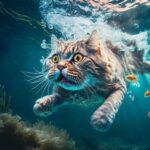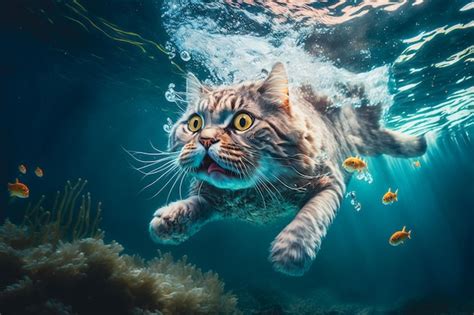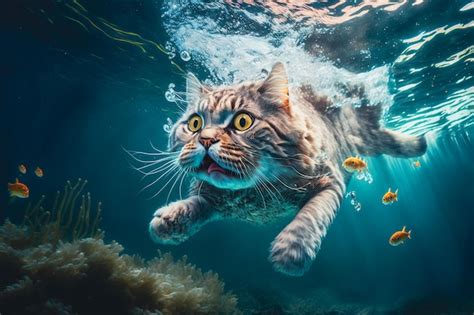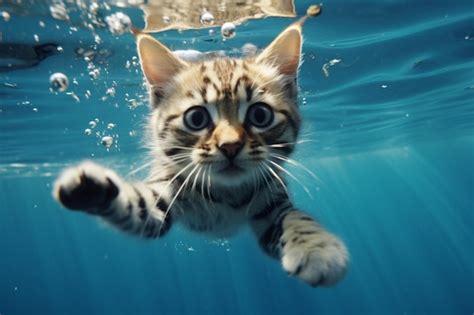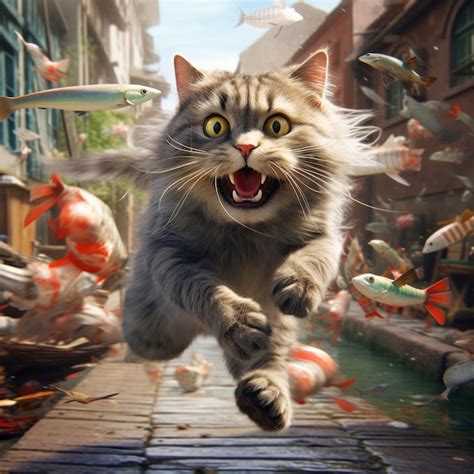
An explosion of AI-generated videos depicting cats participating in Olympic-style diving competitions has captivated the internet, amassing millions of views and sparking a mix of amusement and disbelief. These hyperrealistic, albeit fabricated, scenes showcase felines executing complex dives with improbable grace, prompting widespread discussion about the capabilities and potential impact of artificial intelligence in content creation.
The viral sensation, fueled by platforms like X (formerly Twitter), features digitally rendered cats performing acrobatic feats off diving boards, complete with slow-motion replays and dramatic commentary. While clearly artificial, the videos’ lifelike quality has blurred the lines between reality and simulation, leading some viewers to question their authenticity. “I didn’t realize cats doing Olympic diving was something I needed to see,” remarked one user on X, encapsulating the general surprise and delight surrounding the trend.
The surge in AI-generated content highlights the rapidly evolving landscape of digital media, where sophisticated algorithms can create highly convincing simulations. This raises both exciting possibilities and ethical concerns regarding the dissemination of misinformation and the potential for AI to displace human creativity.
The feline diving videos are not an isolated incident. They represent a broader trend of AI-driven content creation that spans various genres, from music and art to writing and video production. As AI technology becomes more accessible and refined, the volume and realism of synthetic media are expected to increase exponentially.
The viral phenomenon has sparked debate about the implications of increasingly realistic AI-generated content. While many users are enjoying the humorous and imaginative possibilities, others are raising concerns about the potential for misuse, including the creation of deepfakes and the spread of propaganda. The ability to convincingly fabricate events and scenarios could erode trust in traditional media and make it more difficult to distinguish between fact and fiction.
The “AI Cat Olympics” serves as a reminder of the transformative power of artificial intelligence and the need for critical thinking and media literacy in the digital age. As AI continues to evolve, it will be crucial to develop strategies for identifying and addressing the challenges posed by synthetic media.
Expanding on the Phenomenon: The Rise of AI-Generated Media
The “AI Cat Olympics” is more than just a fleeting internet meme; it’s a symptom of a larger technological shift. Artificial intelligence is no longer confined to the realm of scientific research and specialized applications. It’s becoming increasingly integrated into everyday life, powering everything from virtual assistants to recommendation algorithms.
One of the most significant developments in recent years has been the emergence of generative AI models, which are capable of creating new content from scratch. These models are trained on vast datasets of text, images, audio, and video, allowing them to learn the underlying patterns and structures of these data types. Once trained, they can be used to generate new content that is remarkably similar to the data they were trained on.
The applications of generative AI are vast and varied. In the field of art, AI models can create stunningly realistic paintings and sculptures. In music, they can compose original melodies and harmonies. In writing, they can generate articles, stories, and poems. And, as the “AI Cat Olympics” demonstrates, they can also create incredibly convincing video simulations.
Behind the Scenes: How AI Creates the Feline Divers
Creating the “AI Cat Olympics” videos involves a complex process that combines several different AI techniques. First, a generative AI model is used to create the initial images and videos of the cats. This model might be a type of neural network called a Generative Adversarial Network (GAN), which consists of two parts: a generator and a discriminator. The generator creates new images, while the discriminator tries to distinguish between real images and those generated by the generator. Through a process of continuous feedback, the generator learns to create images that are increasingly realistic and convincing.
Once the initial images and videos have been generated, they are then refined using other AI techniques. For example, image editing tools can be used to enhance the details of the cats’ fur and expressions. Motion capture technology can be used to track the movements of real athletes and then apply those movements to the virtual cats. And special effects software can be used to add elements like water splashes and dramatic lighting.
The result is a video that is almost indistinguishable from reality. The cats look and move like real animals, and the diving sequences are both impressive and believable. It’s no wonder that these videos have captured the imagination of so many people.
The Ethical Considerations: Navigating the Age of Synthetic Media
The rise of AI-generated media raises a number of important ethical considerations. One of the most pressing concerns is the potential for misuse. AI can be used to create deepfakes, which are highly realistic videos that depict people saying or doing things they never actually said or did. These deepfakes can be used to spread misinformation, damage reputations, and even incite violence.
Another concern is the potential for AI to displace human creativity. As AI models become more capable of creating art, music, and writing, some fear that human artists and creators will be rendered obsolete. While AI can undoubtedly be a powerful tool for creative expression, it’s important to ensure that it doesn’t come at the expense of human creativity.
Furthermore, the proliferation of AI-generated content can erode trust in traditional media. If people can no longer be sure whether what they are seeing or hearing is real, they may become more skeptical of all sources of information. This could lead to a decline in civic engagement and a weakening of democratic institutions.
Addressing these ethical concerns requires a multi-faceted approach. First, it’s important to develop technologies that can detect AI-generated content. These technologies could be used to flag deepfakes and other forms of synthetic media, making it easier for people to distinguish between real and fake content.
Second, it’s important to promote media literacy. People need to be able to critically evaluate the information they encounter online and understand the potential for manipulation. This includes teaching people how to spot deepfakes, how to identify biased sources, and how to verify information from multiple sources.
Third, it’s important to establish ethical guidelines for the development and use of AI. These guidelines should address issues such as transparency, accountability, and fairness. They should also ensure that AI is used in a way that respects human rights and promotes the public good.
The Future of AI and Content Creation
The “AI Cat Olympics” offers a glimpse into the future of content creation. As AI technology continues to advance, we can expect to see even more sophisticated and realistic synthetic media. This could lead to a revolution in entertainment, education, and communication.
In the entertainment industry, AI could be used to create personalized movies and video games that adapt to the viewer’s preferences. In education, AI could be used to create interactive learning experiences that are tailored to the individual student’s needs. And in communication, AI could be used to create virtual avatars that allow people to interact with each other in a more natural and engaging way.
However, it’s important to remember that AI is a tool, and like any tool, it can be used for good or for evil. It’s up to us to ensure that AI is used in a way that benefits humanity and promotes a more just and equitable world. This requires a commitment to responsible innovation, ethical development, and ongoing dialogue about the implications of this transformative technology. The “AI Cat Olympics” may be a humorous example, but it underscores the need for society to have a serious conversation about the future of AI and its impact on our lives.
The Broader Context: AI and the Evolution of Memes
The AI-generated cat diving videos also tap into the cultural phenomenon of internet memes. Memes, often humorous or satirical images, videos, or text, spread rapidly online, evolving and adapting as they are shared and reinterpreted. The “AI Cat Olympics” builds upon this tradition by using AI to create a novel and unexpected twist on familiar tropes.
The appeal of the meme lies in its absurdity and the contrast between the graceful, athletic nature of Olympic diving and the often clumsy and unpredictable behavior of cats. This juxtaposition creates a humorous effect that resonates with a wide audience. Furthermore, the AI-generated nature of the videos adds another layer of intrigue, prompting viewers to consider the capabilities and limitations of the technology.
The success of the “AI Cat Olympics” highlights the potential for AI to contribute to the evolution of memes. By generating new and original content, AI can inject fresh ideas and perspectives into the meme ecosystem, driving innovation and creativity. However, it also raises questions about the role of human creativity in the meme-making process. As AI becomes more capable of generating memes autonomously, it’s important to consider the implications for human artists and humorists.
Technical Deep Dive: Understanding the AI Models Used
Several different types of AI models could be used to create the “AI Cat Olympics” videos. One common approach is to use a combination of Generative Adversarial Networks (GANs) and diffusion models.
-
GANs (Generative Adversarial Networks): GANs consist of two neural networks: a generator and a discriminator. The generator creates new images or videos, while the discriminator tries to distinguish between real and fake content. Through a process of adversarial training, the generator learns to create content that is increasingly realistic and convincing.
-
Diffusion Models: Diffusion models work by gradually adding noise to an image until it becomes pure noise. Then, they learn to reverse this process, gradually removing the noise to reconstruct the original image. By manipulating the noise removal process, diffusion models can generate new images that are similar to the original but with different characteristics.
In the case of the “AI Cat Olympics,” GANs might be used to generate the initial images of the cats, while diffusion models might be used to refine the details and add realistic textures and lighting. Other techniques, such as motion capture and video editing software, could be used to create the diving sequences and add special effects.
The specific AI models and techniques used will vary depending on the creator’s goals and resources. However, the underlying principle is the same: to use AI to generate realistic and engaging content that blurs the lines between reality and simulation.
The Psychological Impact: Why We Are Captivated by AI-Generated Content
The widespread fascination with the “AI Cat Olympics” and other forms of AI-generated content can be attributed to several psychological factors.
-
Novelty and Surprise: AI-generated content often presents us with something new and unexpected. The sight of cats performing Olympic-style diving is inherently surprising and humorous, capturing our attention and sparking our curiosity.
-
The Uncanny Valley: The “uncanny valley” is a psychological phenomenon that describes our negative reaction to things that are almost, but not quite, human. AI-generated content can sometimes trigger this reaction, as it often comes close to replicating reality but falls short in subtle ways. This can create a sense of unease or discomfort, but it can also be strangely fascinating.
-
Cognitive Dissonance: When we encounter AI-generated content that is difficult to distinguish from reality, it can create cognitive dissonance, a state of mental discomfort caused by holding conflicting beliefs or values. To resolve this dissonance, we may try to understand how the content was created or question our assumptions about reality.
-
The Desire for Connection: AI-generated content can also appeal to our desire for connection and community. By sharing and discussing these videos with others, we can feel a sense of belonging and shared experience.
In summary, the psychological impact of AI-generated content is complex and multifaceted. It can evoke a range of emotions, from amusement and surprise to unease and discomfort. By understanding these psychological factors, we can better appreciate the power and potential of AI to shape our perceptions and experiences.
Addressing Concerns About Misinformation and Deepfakes:
The viral nature of AI-generated content, like the “AI Cat Olympics,” also highlights the urgent need to address concerns about misinformation and deepfakes. While the cat diving videos are clearly intended as entertainment, the technology behind them could be used to create more malicious content.
-
Watermarking and Provenance Tracking: One approach is to develop techniques for watermarking AI-generated content, allowing viewers to easily identify it as synthetic. This could involve embedding invisible markers into the images or videos that can be detected by specialized software. Another approach is to track the provenance of AI-generated content, providing a record of its origin and any modifications that have been made.
-
AI-Based Detection Tools: AI can also be used to detect deepfakes and other forms of synthetic media. These tools analyze the visual and audio characteristics of the content, looking for anomalies that might indicate manipulation. However, deepfake technology is constantly evolving, so detection tools must also be continuously updated to stay ahead of the curve.
-
Media Literacy Education: As mentioned earlier, media literacy education is crucial for helping people to critically evaluate the information they encounter online. This includes teaching people how to spot deepfakes, how to identify biased sources, and how to verify information from multiple sources.
-
Collaboration Between Tech Companies and Media Organizations: Addressing the challenges of misinformation and deepfakes requires collaboration between tech companies and media organizations. Tech companies can provide the tools and platforms for detecting and labeling synthetic media, while media organizations can provide the expertise and resources for educating the public.
The Economic Implications: AI’s Impact on Creative Industries
The rise of AI-generated content has significant economic implications for the creative industries.
-
Automation of Content Creation: AI can automate many of the tasks involved in content creation, potentially reducing costs and increasing efficiency. This could lead to new opportunities for businesses to create and distribute content at scale. However, it could also lead to job losses for human artists and creators.
-
Personalized Content Experiences: AI can be used to create personalized content experiences that are tailored to the individual viewer’s preferences. This could lead to increased engagement and revenue for businesses that are able to leverage this technology effectively.
-
New Business Models: AI could also lead to the emergence of new business models in the creative industries. For example, AI could be used to create virtual influencers or generate personalized advertising campaigns.
-
The Need for New Skills: As AI becomes more integrated into the creative industries, there will be a growing need for workers with new skills. This includes skills in AI programming, data analysis, and content creation.
The economic implications of AI in the creative industries are still unfolding. However, it is clear that this technology will have a profound impact on the way content is created, distributed, and consumed.
The Legal Landscape: Copyright and Ownership of AI-Generated Content
The legal landscape surrounding AI-generated content is still evolving. One of the key questions is who owns the copyright to content created by AI.
-
The Role of Human Input: In general, copyright law protects original works of authorship. This means that the creator of a work must have made some kind of creative contribution to it. If an AI model generates content autonomously, without any human input, it is unclear whether that content is protected by copyright.
-
Copyright Ownership: In some cases, the courts have held that the copyright to AI-generated content belongs to the person who trained the AI model or who provided the input data. However, this is still a developing area of law.
-
Ethical Considerations: There are also ethical considerations surrounding the copyright and ownership of AI-generated content. For example, if an AI model is trained on copyrighted data without permission, it could be argued that the resulting content infringes on those copyrights.
The legal landscape surrounding AI-generated content is complex and uncertain. It is important to stay up-to-date on the latest developments in this area of law to ensure that you are complying with all applicable regulations.
The Future of Entertainment: Beyond the “AI Cat Olympics”
The “AI Cat Olympics” provides a lighthearted glimpse into the potential of AI to transform entertainment. As AI technology continues to advance, we can expect to see even more innovative and immersive entertainment experiences.
-
Interactive Storytelling: AI could be used to create interactive stories that adapt to the viewer’s choices and actions. This would allow viewers to become active participants in the story, rather than passive observers.
-
Virtual Reality and Augmented Reality: AI could be used to enhance virtual reality (VR) and augmented reality (AR) experiences, making them more realistic and immersive. For example, AI could be used to create realistic virtual characters or to generate personalized AR content.
-
Personalized Entertainment: AI could be used to create personalized entertainment experiences that are tailored to the individual viewer’s preferences. This could involve generating custom playlists, recommending movies and TV shows, or even creating personalized video games.
-
AI-Powered Special Effects: AI could be used to create stunning special effects in movies and TV shows, making them more visually impressive than ever before.
The future of entertainment is full of possibilities. AI has the potential to transform the way we experience entertainment, making it more interactive, immersive, and personalized. While the “AI Cat Olympics” is a humorous example, it points to a future where the boundaries between reality and simulation become increasingly blurred.
FAQ: Frequently Asked Questions about AI-Generated Content like the “AI Cat Olympics”
Q1: What is AI-generated content, and how is it created?
AI-generated content refers to text, images, videos, audio, and other forms of media created using artificial intelligence algorithms. These algorithms, often based on machine learning techniques like Generative Adversarial Networks (GANs) and diffusion models, are trained on vast datasets to learn patterns and generate new, similar content. In the case of the “AI Cat Olympics,” AI models are used to create realistic simulations of cats performing diving routines, blending real-world physics with fantastical scenarios.
Q2: Are the “AI Cat Olympics” videos real?
No, the “AI Cat Olympics” videos are not real. They are entirely generated by artificial intelligence. While the videos are remarkably realistic, they are simulations created using AI models trained to mimic the movements and appearance of cats and diving competitions.
Q3: What are the potential dangers or ethical concerns associated with AI-generated content?
While AI-generated content can be entertaining and informative, it also raises several ethical concerns. One major concern is the potential for misuse, including the creation of deepfakes used for spreading misinformation, damaging reputations, or inciting violence. Another concern is the potential for AI to displace human creativity and the erosion of trust in traditional media due to the difficulty in distinguishing between real and fake content.
Q4: How can I tell if a video or image is AI-generated?
Distinguishing AI-generated content from real content can be challenging, but there are several clues to look for. These include inconsistencies in lighting or physics, unnatural movements or expressions, and artifacts or distortions in the image or video. Additionally, tools and techniques are being developed to detect AI-generated content, such as watermarking and AI-based detection algorithms. Critical thinking and media literacy are also essential for evaluating the authenticity of content encountered online.
Q5: What does the rise of AI-generated content mean for the future of creative industries?
The rise of AI-generated content has significant implications for the creative industries. AI can automate many tasks involved in content creation, potentially increasing efficiency and reducing costs. This could lead to new opportunities for businesses to create and distribute content at scale, but it could also lead to job displacement for human artists and creators. The creative industries will need to adapt to these changes by embracing AI as a tool, developing new skills, and exploring new business models. The legal framework surrounding AI-generated content also needs to evolve to address issues of copyright and ownership.




